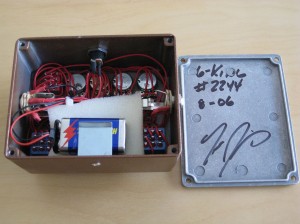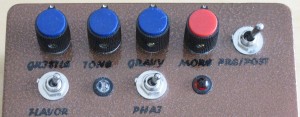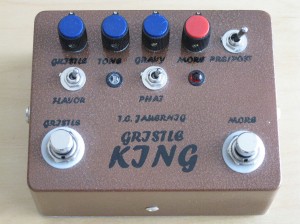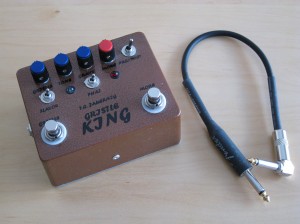Pedal Review: T.C. Jauernig Electronics Gristle King
Introduction
Tim Jauernig is the creator of the ‘Luxury Drive’ and the hilariously named ‘Diabolic Gristle Tone Manipulator’ a.k.a. DGTM (a phrase coined by zany guitarist and Fender clinician Greg Koch). According to his website the Luxury Drive is closer to a booster, while the DGTM is an overdrive pedal. Both pedals have received such rave reviews that Tim’s next creation, the aptly named ‘Gristle King’, was the next logical step essentially combining the Luxury Drive and DGTM into one unit, with a few extra features.
I was on a quest to rationalize my pedalboard which meant that I wanted to have less pedals, but those that I did keep had to be great quality pedals which were versatile so I could cover a wide range of musical styles. More specifically, I wanted a pedal that combined both a boost and an overdrive. There were a few alternatives out there like Fulltone’s Full Drive, Toadworks’ Death Rattle and the Burn Unit by Barber Electronics, but hoping for something different, I finally settled upon the Gristle King.
Features
At first glance, the pedal, finished in a brown baked enamel coat, has a Star Trek-esque vibe to it. From the cylindrical knobs to the diminutive switches, it looks like a tricorder or some similar device. However it is lighter than it looks and the cold metal chassis feels very sturdy. Tim builds and tests all his pedals which usually bodes well for the quality of the pedal.
The bottom plate is secured by four screws which you will need to remove to gain access to the battery compartment and the pedal’s internals. I was pleased to see the high standard of point-to-point wiring and the item number and QA signature on the bottom plate. Very nice…..

The pedal has one knob for the Luxury Drive aspect, and 3 knobs for the DGTM side: Gristle (Drive/Gain), Tone, and Gravy (Volume). Tim has also built in 3 more switches which gives the pedal additional options. The ‘Flavour’ switch basically provides a mid-range boost while the ‘Phat’ switch adds a little more bottom end. The ‘Pre/Post’ switch allows you to place the Luxury Drive booster either pre- the DGTM, essentially giving you another gain stage, or post- which boosts the volume of the DGTM. To me, this unique switch is simply the most brilliant idea since chocolate ice cream! Finally, there are 2 extremely bright LEDs that light up blue when you engage the DGTM, and red when you engage the Luxury Drive.

As a quick aside, some pedals (like wahs) dull your tone when they are off, and BOSS pedals have a buffer circuit which can alter your tone slightly (depending on who you ask) when they are off. However, most handmade pedals have true-bypass circuitry which mechanically disengages the pedal from your signal path to ensure that there is nothing in between your guitar and the amp. The Gristle King has true-bypass circuitry and I was pleased to hear no discernible impact on my tone when it was off.
In Action
When I engaged the Luxury Drive, the first thing I noticed was how transparent it was. I could still recognise my Maton MS500 and Fender Blues Jr through this pedal but it also added a little bit of upper-end sparkle to my tone. As Greg Koch put it: treblelicious! The next thing I noticed was how responsive it was to my playing dynamics. Played lightly, the sound stayed clean, but when I started to dig in it growled! You can also dial back the volume on your guitar to clean up your sound. I enjoy playing the blues, but with this side of the pedal engaged, I REALLY enjoyed playing the blues! Also, no matter how hard I slammed out my chords, there was always a clarity there. Compared to a Tubescreamer-type boost, the Gristle King had slightly less mid-range which I found ideal for my humbucker-equipped Maton. The more I play, the more I’m convinced that you should just leave this part of the pedal permanantly on!
The other half of the pedal is the DGTM Overdrive. The first thing I want to say is that this will not give you hi-gain, nu-metal sounds, so if you’re after something in that vein, look elsewhere. However for everything else it’s perfect. It will cover pop, rock, blues, country and most other styles. The controls (Gain, Tone and Volume) are all responsive and useable throughout their entire range. You can go from a slightly beefier version of the Luxury Drive (think Tubescreamer with a little more hair and a little less mids) to sweet singing compressed drive with bags of sustain. The compression is set just right which is why the pedal is so responsive to your playing. There is also a transparency to the pedal that also surprised me. It still sounded like my guitar and amp, and I could hear each note in every chord I played clearly (and that included all my mistakes too!). Depending on your settings and setup, it may be difficult to hear a difference between the two modes of the Flavour switch, while the Phat switch added a slight boost to my lows without being overly flabby. In most cases the switching options allow for subtle variations on the great quality tones of the Gristle King.
The ‘Pre/Post’ switch introduces yet another variable into the mix. With it, you can have your solo boosted when you engage the Luxury Drive, or place it Pre-DGTM for a second gain stage. Personally, I preferred the ‘Post’ position, with the Luxury Drive adding that delicious sparkle to the DGTM, as opposed to the ‘Pre’ position which confers additional gain to the DGTM which already has plenty in supply.
Conclusion
I must reiterate how much I love the transparency and responsiveness of this pedal, and especially the sparkle of the Luxury Drive which breathed fresh life into my playing. The additional voicings provided by the ‘Flavour’ and ‘Phat’ switch ensures that only the fussiest of tone purists will be unable to find a tone that they like. If you can get your hands on this pedal (I believe there’s quite a long waiting list at the moment), don’t hesitate and just take the plunge!
For more information on the T.C. Jauernig Electronics Gristle King, and other T.C. Jauernig Electronics effects pedals, visit their website.
Sound Bytes
Reviews are highly subjective. Player setups, playing environments, and player techniques all have a significant impact on what tone you will get out of your gear. Even the age of a player could have an impact as your hearing can change over the course of your life. As such, I try to list all aspects of the gear used so you can judge for yourself how my setup might influence the reviewed item and how it might sound with your own gear.
Equipment used for this review:
Maton MS500 Mastersound Electric Guitar, equipped with a Seymour Duncan SH-PG1 ‘Pearly Gates’ humbucker (neck) and a Seymour Duncan SH-4 ‘JB Model’ humbucker (bridge with coil-split). For the sound-bytes below, I selected the SH-4 and engaged the coil-split to get a single-coil sound. Volume and tone knobs were up full. The guitar is strung with Elixir Nanoweb 10’s.
Fender Blues Junior – Tweed Edition, a 15-watt all-tube amp equipped with a 12″ Jensen C12 ceramic speaker. The controls were set as follows: Volume 5, Treble 6, Bass 6, Mid 6, Master 6, Reverb 0, Fat Switch Off. Preamp tubes are Sovteks and power amp tubes are Fender Groove Tubes.
Signal Chain: Guitar -> Gristle King -> Amp
Recording setup: I used a Zoom H2 recorder set around 2 metres (approx 6.5 feet) in front of the amp. I opted for this method (versus a Shure SM57 as close to the speaker as possible) as I felt it conveyed a more realistic sound. SM57’s also have a mid-range hump which colours the sound (albeit favourably). And who plays a guitar wth their ear right up against the speaker, anyway? The only post-processing done was to normalise the .wav file before converting it to .mp3 format on Adobe Audition 3.
Sound files & Notes
Play: Gristle King Blues Riff – Single Coil – Bridge Position
Without the pedal, note the bright nature the single-coil pickup and the Elixir Nanoweb strings, as well as the click of the pick against the strings. Amp is set to just on the verge of breakup, and I’m strumming with average force, so the sound is still clean.
With the Luxury Drive engaged, you can hear the extra sparkle and drive instantly. Treblelicious! There is a very controlled hike in the mid-range which flatters single-coils and adds that extra ‘bite’ that is not too harsh. However, also note the transparency of the Luxury Drive. The character of the guitar, strings and amp is enhanced, but still very recognizable. There is also slightly more sustain.
With the DGTM engaged, you lose some sense of the guitar, amp and string’s character but I had the gain knob set generously at the 12 o’clock position. A little more mid-range is added along with a bucket-load of gain. You can hear the bell-like quality as I strum the last chord as well. Basically, the DGTM will give you loads of drive, and sustain without sacrificing much chord clarity, which makes it very versatile.
*****
Play: Gristle King Arpeggio – Single Coil – Bridge Position
Similar to the blues riff, the Luxury Drive adds that extra sparkle and boost when engaged without overly colouring the basic tone of the setup. The DGTM almost gets a little muddy in some areas, but this can be easily solved by some EQ adjustment on the amp. The mids on the Blues Junior can introduce some un-musical distortion, but I kept the tone controls at 6 for all the recordings for consistency of comparison.
*****
Play: Gristle King Solo – Single Coil – Bridge Position
The Luxury Drive turns what is otherwise an uninspiring solo into something that makes your ears ‘sit up and listen’. Interestingly, the DGTM solo lacks much of the treble of the first two solos, but still has an authoritative, meaty feel to it. The low-end is very tight and the extra mids should it cut through the mix in a band situation.
*****
Play: Gristle King Strum – Single Coil – Bridge Position
The Luxury Drive adds some body to the clean sound. The sparkle is still there. Note the compression that the DGTM introduces compared to the more dynamic sound of the Luxury Drive. However, you can still hear most of the chords clearly, despite my playing!



Leave a Reply